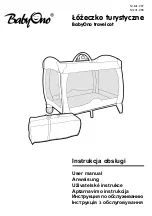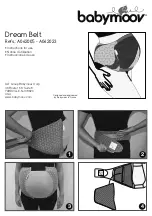
Page 3:X
SIGMA TANDEM SYSTEM OWNER’S MANUAL
11301 - 00.00.0000
Section 3: Intructor Techniques • Chapter2 - In-aircraft & Exits
The second procedure is a diving type exit. This requires the student to change body position immediately upon exit.
If the student cooperates, then the Tandem Instructor's job is much easier. If the student gets into a less-than-ideal
body position, then the Tandem Instructor will have to work harder to maintain stability. This exit can be done from
kneeling, sitting or standing positions.
Diving exit:
This technique, for many aircraft, is most preferred as it limits the amount of time the Tandem pair spends at the open
doorway, or hanging outside the aircraft. There have been many accidental deployments in the past due to student
interference during climbout for poised or backout exits.
The diving exit will require a more intense arch by the Tandem Instructor to maintain stability. It’s recommended that
you spend a few extra minutes on the ground working on the student’s body position as well. This means the student
will have to transition to the freefall body position immediately after the exit.
Illustration #3/2-109 shows the Tandem pair sitting at the door edge of a Pilatus Porter with feet on the step, just prior
to diving out.
B. Exit tips:
Ideally:
1) Spend as little time as possible while hanging onto the outside of the aircraft, or while near the door. The longer
you spend there, the more you increase the chance of something going wrong.
2) The student must have a good grip on their own main lift web. A student with free hands can only get you into
trouble.
3) The student’s head should be back, body arched, feet together, and weight totally supported by you, before exit.
4) The actual exit should be so smooth that the student hardly notices the difference between hanging under you,
outside the aircraft, or in freefall.
5) The fall away from the aircraft should be head high and very stable. The more unstable your exit and fall away, the
more likely the student is to move, which will cause trouble.
6) If exiting from a small side door such as that found on Twin Beeches, Queen and King airs, etc... a kneeling, sitting
or walkout exit is recommended. Do not use a standing back-out exit as the likelihood of an accidental activation is
high.
C. Exiting different aircraft
Five classes of aircraft come to mind.
1) Cessna with step and strut.
2) Cessna, Piper, or Beech with small cargo door (one in which you can’t stand up - usually no outside step).
3) Caravan or Twin Otter with large cargo door.
4) Skyvan, Casa, or other tailgate aircraft.
5) Helicopter with side door.
Before taking a student out of an unfamiliar aircraft the Tandem Instructor must first take an experienced jumper as
student once or twice until he is comfortable with the climbout and exit from that aircraft.
It is difficult to over emphasize the importance of a stable exit on EVERY Tandem jump.
Note: A Tandem jump does not proceed directly from exit to drogue fall. There is freefall in between the time you
leave the aircraft and the time the drogue deploys. This is where stability is gained from freefall body position and
easily maintained without the drogue. Do not use the drogue to gain stability. Documented proof that a Tandem
Instructor routinely uses the drogue to gain stability will quickly result in his rating being suspended.
Summary of Contents for TANDEM VECTOR
Page 1: ......
Page 4: ......
Page 6: ...CHAPTER 1 THESIGMA TANDEMSYSTEM CHAPTER 1 THESIGMA TANDEMSYSTEM...
Page 11: ......
Page 12: ...CHAPTER 2 APPLICANT COURSE INFORMATION CHAPTER 2 APPLICANT COURSE INFORMATION...
Page 17: ......
Page 19: ...CHAPTER 1 DESCRIPTION CHAPTER 1 DESCRIPTION...
Page 31: ......
Page 32: ...CHAPTER 2 OPERATION CHAPTER 2 OPERATION...
Page 38: ......
Page 39: ...CHAPTER 3 RESERVE CONTAINER CHAPTER 3 RESERVE CONTAINER...
Page 71: ......
Page 72: ...CHAPTER 4 MAINCONTAINER CHAPTER 4 MAINCONTAINER...
Page 104: ......
Page 106: ...CHAPTER 1 PREPARATION CHAPTER 1 PREPARATION...
Page 114: ......
Page 115: ...CHAPTER 2 IN AIRCRAFT EXITS...
Page 118: ......
Page 119: ...CHAPTER 3 FREEFALL DROGUE FALL CHAPTER 3 FREEFALL DROGUE FALL...
Page 125: ......
Page 126: ...CHAPTER 4 CANOPY CONTROL CHAPTER 4 CANOPY CONTROL...
Page 130: ......
Page 132: ...CHAPTER 1 RESERVE PROCEDURES CHAPTER 1 RESERVE PROCEDURES...
Page 135: ......
Page 136: ...CHAPTER 2 AIRCRAFT EMERGENCIES STUDENT REFUSAL CHAPTER 2 AIRCRAFT EMERGENCIES STUDENT REFUSAL...
Page 139: ......
Page 140: ...CHAPTER 3 FREEFALL CHAPTER 3 FREEFALL...
Page 145: ......
Page 146: ...CHAPTER 4 CANOPY CONTROL CHAPTER 4 CANOPY CONTROL...
Page 149: ......
Page 151: ...CHAPTER 1 STUDENTSKILLS FORFIRSTJUMP CHAPTER 1 STUDENTSKILLS FORFIRSTJUMP...
Page 155: ......
Page 156: ...CHAPTER 2 OTHER ACTIVITIES CHAPTER 2 OTHER ACTIVITIES...
Page 159: ......
Page 160: ...APPENDIX...
Page 167: ...SIGMATANDEMSYSTEMOWNER SMANUAL Page8 X Section6 Appendix 11301 00 00 0000...
Page 168: ...Page9 X SIGMATANDEMSYSTEMOWNER SMANUAL 11301 00 00 0000 Section6 Appendix...
Page 169: ...SIGMATANDEMSYSTEMOWNER SMANUAL Page10 X Section6 Appendix 11301 00 00 0000...
Page 170: ...Page11 X SIGMATANDEMSYSTEMOWNER SMANUAL 11301 00 00 0000 Section6 Appendix...
Page 171: ...SIGMATANDEMSYSTEMOWNER SMANUAL Page12 X Section6 Appendix 11301 00 00 0000...
Page 172: ...Page13 X SIGMATANDEMSYSTEMOWNER SMANUAL 11301 00 00 0000 Section6 Appendix...
Page 173: ...SIGMATANDEMSYSTEMOWNER SMANUAL Page14 X Section6 Appendix 11301 00 00 0000...
Page 174: ...Page15 X SIGMATANDEMSYSTEMOWNER SMANUAL 11301 00 00 0000 Section6 Appendix...
Page 175: ......
















































